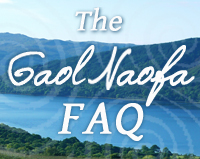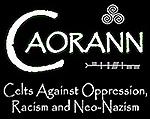Tag: gaelic polytheism
Before we get onto discussing our new video, we’d like to take this opportunity to announce a new member of An Chomhairle Ghaol Naofa (The Gaol Naofa Council). Marsaili Ros has joined the council as our new Brughaidh (“hospitaller”), and we’re very pleased to welcome her to the team! Along with our three other Brughaidhi, Marsaili will be overseeing all aspects of hospitality and member relations within the organisation, and will be involved in all of the usual decision-making the council is responsible for. Since Marsaili has joined us, we’ve updated our Organisational Structure page, and have also added a new page to the Gaol Naofa site detailing our Membership Guidelines to make them easier to find.
Each month, as the first sliver of the new moon appears in the sky, members of Gaol Naofa join together to welcome the return of the moon and honour An Trì Naomh. In our latest video, we explore the Gaelic lore and traditions in which our rites are rooted:
To the Gaels, the “new moon” is a bit different from what astrologers call the “new moon.” In astrology, the “new moon” refers to the exact, astronomical conjunction of the moon and the sun; this is the period when no moon is seen in the sky at all, usually for a period of about three days. In colloquial use, some refer to this period of no visible moon as “the dark of the moon.” In the Gaelic lore, however, the “new moon” refers to the very first sliver that shows in the sky after this period of darkness.
As Alexander Carmichael describes in the Carmina Gadelica, each month at the new moon it was traditional to greet the first visible crescent seen in the sky. Surviving lore about this tradition can also be found in the Isle of Man and Ireland. You can find an overview of this lore, with pointers to further reading, at Tairis: Daily Practices: Prayer to the Moon.
In Gaol Naofa we have continued this tradition as a way of helping our international membership — some of whom may be spread far and wide from one another — share in a sense of community as we come together and honour the gods, spirits, and ancestors. The prayers given in this video are from the Carmina Gadelica (Volume III), with translations by Kathryn Price NicDhàna; for more information on how we approach adapting and translating prayers from the Carmina, see our article on Prayer in Gaelic Polytheism (especially pages 6-7). For more on making offerings, see our article on Offerings in Gaelic Polytheism.
Fàilte ort féin, a ghealach ùr
Àilleagan cùmh nan nèamh!
I welcome you, new moon
Shining strength of the skies!
February 20, 2015
On January 21st news broke of a terrible act of desecration: A statue of Manannán mac Lir, which had been situated at the Gortmore viewing point, near Limavady in Co. Derry, since 2013, had been stolen. The thieves had used power tools to remove the statue of Manannán from its base, and in its place they had left a large wooden cross inscribed with the first commandment, “You shall have no other gods before me.”
The statue was installed by the local council as part of a myth and heritage trail, and it is – or was – one of five such sculptures in the area. To some people the statue was a popular place to visit and take photographs, while to others it was a place of pilgrimmage, and a celebration of the area’s history, heritage, and culture. To us as Gaelic Polytheists, the statue of Manannán was beautiful and sacred, and its theft – and the apparently religious motivations behind it – has shocked, saddened, and angered so many of us.
In the past week, messages of support and solidarity have been pouring in to a group set up to celebrate the statue and help raise awareness of its theft, and the story has gained international attention of truly staggering proportions, in both the mainstream press and more specialised news outlets such as The Wild Hunt, who approached us for comment on the story. Although as yet no news of the statue’s whereabouts has emerged, or who may be responsible for the theft, we are still hoping and praying for justice and the safe return of Manannán mac Lir to the Limavady area. As long as the statue is being talked about, as long as awareness is being raised and spread, there is hope that justice will be done.
As we told The Wild Hunt, Gaol Naofa has been covering the story closely on our Facebook page as the search continues, and we have been producing memes to share and posting resources for those who might be looking for some inspiration in their own spiritual work to help return the statue, including traditional songs and prayers. We have now created a new page here on the Gaol Naofa website to host all of the images in one place, which you can find in the Resources section of our Library.
Like so many people who’ve been shocked and appalled by the actions of the individuals responsible for the theft, we want to do what we can to support the community of Limavady (and others who’ve been deeply saddened by this act of desecration) and would like to help in whatever way we can as the search continues. As part of that, we’ve now produced a new video, which discusses the theft and outlines a prayer that’s been specially written for the occasion, and has lyrics to a traditional song for you to sing:
We invite you to join your voices with us in singing him home!
A Mhanannáin, A Mhanannáin,
Son of the Sea, we are calling you home.
Son of the Sea, we are calling you home.
January 30, 2015
Rounding off our series of videos on the festivals of the Gaelic year, we now have the final two installments which are covering the Midwinter period. In spite of the fact that the festivities at this time of year aren’t Gaelic in origin, they’ve come to be important occasions and have taken on many Gaelic elements in the ways they’re celebrated, which means that some of us may choose to observe Midwinter celebrations with friends and family in a secular, or more culturally-focused way.
As with our other videos, we take a look at the origins of the festivities and how they might be celebrated by Gaelic Polytheists today, and because of the concentration of celebrations that can be found at this time of year we’ve split them into two separate videos. First we have Grianstad an Geimhridh — The Winter Solstice, covering the roots of the festivities as evidenced by the ancient, pre-Celtic monuments like Newgrange and Maes Howe (which are aligned to the winter solstice), through to the Christian and Norse influences with Christmas, the peculiar and uniquely Gaelic traditions surrounding Saint Stephen’s Day, called Lá an Dreoilín (or Wren Day) in Ireland, and the traditions of the Yule log, the latter of which is identified with the Cailleach in Scotland.
Our second video takes a look at the secular New Year, with the Scottish celebrations of Hogmanay (New Year’s Eve) at the forefront. While Gaelic Polytheists might view the new year as beginning with Samhain, some of us may also choose to observe the secular new year, perhaps especially those of us who are Scottish-oriented in our practices. The new year only shifted to January 1st in 1600 (in Scotland; 1752 for Ireland), but Scotland’s complex religious history, which saw Christmas being effectively banned for four hundred years, means that the New Year has long been one of the most eagerly anticipated and celebrated dates in the modern calendar. As with any other liminal period in the Gaelic festival year, Hogmanay sees a concentration of protective rites and communal feasting, but while the original reasons for its popularity (the banning of Christmas) are no longer a factor, it has arguably come to be a celebration of culture and heritage as much as it might be a good excuse for a party.
Over all, the focus of the traditions that are attached to this time of year are on the family (whatever that might mean to you) and loved ones, and in appreciating the warmth and light of the hearth and home in the depth of the winter cold and darkness. As the secular year comes to a close, as the days begin to lengthen once again, Gaol Naofa would like to wish everyone a happy and prosperous new year. “Yule gude and yule gere, Follow de trew da year.”
Fàs is gnàths is toradh.
December 15, 2014
Next page
Previous page
Bennacht nime, nél-bennacht,
Bennacht tíre, torad-bennacht,
Bennacht mara, íasc-bennacht
Gaelic Polytheism
On Social Media
Gaol Naofa Supports
2017 Calendar
25 January — Burns Night
31 January — Gealach Ùr
1 February — Lá Fhéile Bríde
1 March — Gealach Ùr
17 March — Lá Fhéile Pádraig
18 March — Sheelah's Day
25 March — Là na Caillich
29 April — Gealach Ùr
1 May — Lá Bealtaine
28 May — Gealach Ùr
21 June — Grianstad an tSamhraidh
27 June — Gealach Ùr
5 July — Laa Tinvaal
26 July — Gealach Ùr
1 August — Lá Lúnasa
24 August — Gealach Ùr
23 September — Gealach Ùr
29 September — Là Fhèill Mìcheil
22 October — Gealach Ùr
31 October — Oíche Shamhna
21 November — Gealach Ùr
30 November — Latha Naomh Anndra
21 December — Gealach Ùr
21 December — Grianstad an Gheimhridh
26 December — Lá an Dreoilín
31 December — Hogmanay







